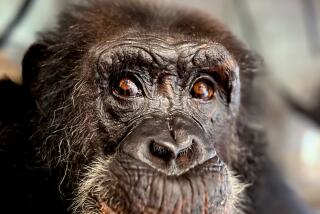Great apes have midlife crises too, study finds
- Share via
At middle age, a great ape will neither cheat on a spouse nor buy a red sports car on impulse. But researchers have found that chimpanzees and orangutans experience midlife crises just as surely as do humans.
That finding, published Monday in the Proceedings of the National Academy of Sciences, could upend firmly held beliefs about the roots of human happiness and the forces that influence its odd trajectory across the life span. If our animal relatives share our propensity for sadness, withdrawal and frustration at life’s midpoint, perhaps the midlife crisis is actually driven by biological factors — not the wearing responsibilities of jobs and family and the dawning recognition of our mortality.
“This opens a whole new box in the effort to explain” the midlife dip in well-being, said senior author Andrew Oswald, a behavioral economist at the University of Warwick in England. “It makes one’s head spin.”
For men and women alike, social science researchers have located the winter of our discontent somewhere near the 50-year mark, wedged neatly between the vigor and drive of youth and the quest for meaning and happiness that marks the final decades of life. More than just a cultural cliche, the midlife crisis is the well-documented nadir of human well-being on the U-shaped curve of happiness that stretches between birth and death.
As happiness researchers have fanned out around the globe, they have documented this midlife trough in at least 65 countries, suggesting that it is a universal feature of human existence.
Until now, however, the social scientists that have dominated this burgeoning field of study have drawn on economic, psychological and sociological explanations. By midlife, youth’s hot-blooded drive to mastery has driven off. Responsibilities abound. Decades of striving — to raise a family, to establish oneself in the community, to climb the professional ziggurat — have shown us the mountaintop and, with it, the limits of our reach and usefulness. A recognition of our mortality settles in.
In the years after midlife, the theory goes, humans shoulder fewer burdens for the care of others. Their time horizons are shorter, prompting them to focus on people and activities that give pleasure and meaning to their lives. They regret less.
Oswald had a hunch that these explanations were overlooking the fundamental role of biology in influencing mood. So he reached out to Alexander Weiss, a primatologist and evolutionary psychologist at the University of Edinburgh in Scotland who studies well-being in great apes.
The pair put together an international team of primatologists from Scotland, Japan and Arizona and devised an unprecedented census of well-being among 336 chimpanzees and 172 orangutans of all ages living in two research centers, one sanctuary and nine zoos across five countries.
To gauge the animals’ well-being, the researchers turned to the keepers that knew them best and asked them a series of questions that might stymie even the most devoted dog or cat owner. Designed to capture the mood, sense of effectiveness and pleasure-seeking drive of apes across the life span, the questions were based on established methods of measuring human well-being but modified for this population.
Keepers were asked to rate the positive or negative mood of each subject and to gauge the degree of pleasure the animal derived from social situations. A third question was how successful each great ape was in achieving its goals — whether winning a mate, commanding the attention of a fellow member of its social group or gaining hold of an out-of-reach toy. Finally, the study authors asked keepers to consider how happy they would be if they had to live as their chimpanzees or orangutans for a week.
When the composite well-being score for each ape was plotted according to his or her age, the result was the same distinctive U-shaped curve seen universally in humans. Around the ages of 28 and 35 — roughly the midpoint of the chimpanzees’ and orangutans’ expected life spans — moods sagged, animals became less socially engaged and they were less likely to persist in attaining the things they desired.
“I certainly was shocked,” Oswald said.
While highly sociable, great apes lack the hallmarks of humanity most often associated with a drop in mood and well-being at midlife — the ability to evaluate one’s status relative to expectations, an awareness of one’s mortality, and social and family responsibilities so burdensome they might induce stress.
And yet, noted Weiss, middle-aged chimps and orangutans experience more anxiety and less pleasure than their younger counterparts, and they’re just not as successful at getting what they want. “You’d probably see it in their posture,” he said: They are just not loving life.
For social scientists who saw shifts in happiness in strictly human terms, the findings were a forceful reminder that people have not evolved as far as we may think beyond the great apes, said Stacey Wood, a neuropsychologist at Scripps College in Claremont who wasn’t involved in the study.
“It’s a little humbling,” said Wood, whose research focuses on the effects of age on happiness and emotional restraint.
For animals that live in mutually dependent societies, the findings suggest that a midlife drop in sociability serves some positive evolutionary purpose, she said.
“It pushes more toward the possibility that this is biological,” added Arthur Stone, a professor of psychiatry at Stony Brook University in New York who was not involved with the study.
Whether it’s hormones, brain structure, neurochemicals or some other factor that causes the middle-aged psyche to power down will require further research, Stone said. But from now on, he said, social explanations alone will not suffice.
Oswald, who describes himself as “58 and very happily accelerating,” said that for forlorn midlifers, the study is a happy reminder that while humans may be programmed to suffer a dip in pleasure, it gets better.
“This suggests that it’s completely normal, and that it’s apparently out of your control,” he said.







